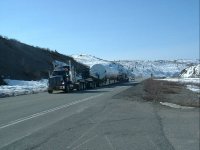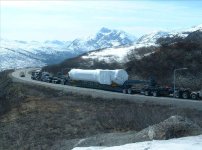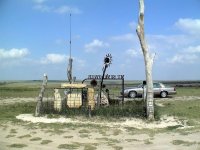You are using an out of date browser. It may not display this or other websites correctly.
You should upgrade or use an alternative browser.
You should upgrade or use an alternative browser.
Tractor stability going uphill vs. down
- Thread starter rfc143
- Start date
- Views: 24232
More options
Who Replied?
/ Tractor stability going uphill vs. down
#21
k0ua
Epic Contributor
Thanks for all the input. After further consideration, I've decided to move to Kansas.
Well, can't say that I would blame you. I deal with these issues every time I operate my tractor. Yes I have taken the 0 chit ride to the bottom of the hill more than once and on more than one tractor. It happens. When I moved here from the flat lands I sold my tractor as I didn't think I could operate a tractor safely here. BUT I missed it so much I bought another tractor and that was 3 tractors ago. I have learned much, and I am still alive.
FTG-05
Elite Member
- Joined
- Jan 7, 2011
- Messages
- 2,593
- Location
- TN
- Tractor
- Kubota L4330 GST w/FEL, Kubota RTV-XG850, Kubota ZD326S
Ya; You're right; My bad. "Kansas is flat as a pancake". It's not. So let's go with THE flattest state in the union: Florida. Although I guess there're sink holes. But if you go into one of them, it's not going to matter if you're in 4 wheel drive or not; if you have loaded tires or not; if you have weight on the front, back or in between.I don't know about that. Kansas has some pretty mean hills.
Here are some Walrus Breeding Tanks going over a small pass in KS back in the early 2000's. Seems like some pretty decent slopes there.....
View attachment 508136View attachment 508137
MossRoad
Super Moderator
- Joined
- Aug 31, 2001
- Messages
- 66,201
- Location
- South Bend, Indiana (near)
- Tractor
- Power Trac PT425 2001 Model Year
I don't know about that. Kansas has some pretty mean hills.
Here are some Walrus Breeding Tanks going over a small pass in KS back in the early 2000's. Seems like some pretty decent slopes there.....
View attachment 508136View attachment 508137
First we learn Kansas has hills and now we learn they have Walrus, too!
AxleHub
Elite Member
First we learn Kansas has hills and now we learn they have Walrus, too!
And that Florida is the flattest state. . . . Here I would have guessed Nebraska.
4570Man
Super Star Member
- Joined
- Apr 7, 2015
- Messages
- 19,042
- Location
- Crossville, TN
- Tractor
- Kubota M59, Kubota L3800, Grasshopper 428D, Topkick dump truck, 3500 dump truck, 10 ton trailer, more lighter trailers.
Its very unlikely to happen. Usually it's the tractors power rotating it backwards on the back axel. Once the implement hits the ground and the lift bottoms out it breaks your traction and moves the pivot farther back.Correct me if I'm wrong but the 3pt can be pushed up- the tractor does not lock the 3pt or push down on it. So an implement on the 3pt won't prevent the tractor from flipping over backwards. But the loader can push down so the bucket would help prevent flipping over the front axle. I have a steep road with stuff at the top that needs chipping. I've been waiting for the road to dry but my plan is to back up it in 4wd with the loader bucket near the ground. The 1000lb chipper on the back should help too.
CalG
Super Member
- Joined
- Sep 29, 2011
- Messages
- 9,213
- Location
- vermont
- Tractor
- Hurlimann 435, Fordson E27n, Bolens HT-23, Kubota B7200, Kubota B2601
I don't know about that. Kansas has some pretty mean hills.
Here are some Walrus Breeding Tanks going over a small pass in KS back in the early 2000's. Seems like some pretty decent slopes there.....
View attachment 508136View attachment 508137
Can you pleas tell me where in KS those mountains in the back ground are located?
Colorado maybe?
MossRoad
Super Moderator
- Joined
- Aug 31, 2001
- Messages
- 66,201
- Location
- South Bend, Indiana (near)
- Tractor
- Power Trac PT425 2001 Model Year
The lowest point in Kansas is 679 feet above sea level.
The highest point in Kansas is Mount Sunflower at 4039, just east of the Colorado border....
Doesn't look too mountainous....
Perhaps he was mistaken...

Sources:
Kansas Base and Elevation Maps
Mount Sunflower - Wikipedia
The highest point in Kansas is Mount Sunflower at 4039, just east of the Colorado border....
Doesn't look too mountainous....
Perhaps he was mistaken...
Sources:
Kansas Base and Elevation Maps
Mount Sunflower - Wikipedia
Attachments
k0ua
Epic Contributor
That Mt Sunflower looks like good tractor country to me...
FTG-05
Elite Member
- Joined
- Jan 7, 2011
- Messages
- 2,593
- Location
- TN
- Tractor
- Kubota L4330 GST w/FEL, Kubota RTV-XG850, Kubota ZD326S
Can you pleas tell me where in KS those mountains in the back ground are located?
Colorado maybe?
Let me guess, and I'm probably going out on a limb here, a real shot in the dark if you will:
You really, really believed those were Walrus Breeding Tanks didn't you? Go ahead admit it. I won't laugh at you. Much.
ETA :laughing: (so that people know I'm messin' with them)
Last edited:
FTG-05
Elite Member
- Joined
- Jan 7, 2011
- Messages
- 2,593
- Location
- TN
- Tractor
- Kubota L4330 GST w/FEL, Kubota RTV-XG850, Kubota ZD326S
The lowest point in Kansas is 679 feet above sea level.
The highest point in Kansas is Mount Sunflower at 4039, just east of the Colorado border....
Doesn't look too mountainous....
Perhaps he was mistaken...

Sources:
Kansas Base and Elevation Maps
Mount Sunflower - Wikipedia
And yet again another WBT believer reveals hisself to the world.
ETA :laughing: (so that people know I'm messin' with them)
Last edited:
FTG-05
Elite Member
- Joined
- Jan 7, 2011
- Messages
- 2,593
- Location
- TN
- Tractor
- Kubota L4330 GST w/FEL, Kubota RTV-XG850, Kubota ZD326S
Alright, back to the thread, sorry for the hijack, if you want a tutorial on WBTs, start another thread, I'm done hijacking the OP's thread (unless, of course, I can find my pics of the WBTs on a very large US Army base deep in the FL Everglades....). Although it has been fun, it's not fair to the OP.
Regarding backing up long hills, especially with a bushhog.
Look at these three pics; note how high the vegetation is, particularity the Poke Salad Annie (don't recall it's scientific name). In these pics, it's about 10-12' high, I was sitting in my tractor (L4330) when I took the pics.

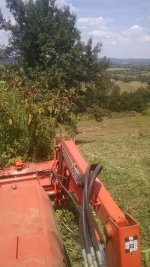
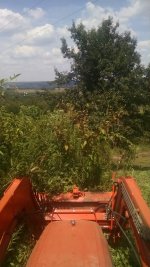
Basically, there is no way to realistically go backwards against that heavy and high vegetation. I can barely go up the hill forwards and only by taking a small 3-4' cuts instead of a full width 6' cut. I couldn't see crap going forward, there's no way to see anything going backwards.
BTW, that was the first time I bushogged my field after I bought the place. I first BH'd it August 2014 and it was probably 3-4 years since it was last BHd. There was a thread here on TBN about bushhogging my hills from around that time, but I can't find it right now.
Regarding backing up long hills, especially with a bushhog.
Look at these three pics; note how high the vegetation is, particularity the Poke Salad Annie (don't recall it's scientific name). In these pics, it's about 10-12' high, I was sitting in my tractor (L4330) when I took the pics.



Basically, there is no way to realistically go backwards against that heavy and high vegetation. I can barely go up the hill forwards and only by taking a small 3-4' cuts instead of a full width 6' cut. I couldn't see crap going forward, there's no way to see anything going backwards.
BTW, that was the first time I bushogged my field after I bought the place. I first BH'd it August 2014 and it was probably 3-4 years since it was last BHd. There was a thread here on TBN about bushhogging my hills from around that time, but I can't find it right now.
Alright, back to the thread, sorry for the hijack, if you want a tutorial on WBTs, start another thread, I'm done hijacking the OP's thread (unless, of course, I can find my pics of the WBTs on a very large US Army base deep in the FL Everglades....). Although it has been fun, it's not fair to the OP.
As the OP, I appreciate that, although I have thoroughly enjoyed it.
I asked the original question, not so much with a view to bush-hogging, as for general hillside work. I'm in the process of pushing in new trails on the 25 acre wooded hillside I have to work with, and have longed for some guide posts to work with. Crane operators have precise angle charts/weights that define the operating parameters their machine is capable of. Why not tractor owners. 10 degrees? 15 degrees? 20 degrees?
I have an inclinometer mounted in the tractor, but other than reading accounts from other readers, it's like the only way to know for sure where the bounds of the envelope are, is to roll your tractor once (a bit of an overstatement, but you get the idea).
I have learned so far that weight and balance is only part of the challenge; traction is as much if not more of a factor, in that you may be fine on a slope from a W/B perspective, but if you start sliding, all bets are off; the tractor might skid to an angle on the slope and then you have a problem. Great input so far though, for which I'm grateful.
FTG-05
Elite Member
- Joined
- Jan 7, 2011
- Messages
- 2,593
- Location
- TN
- Tractor
- Kubota L4330 GST w/FEL, Kubota RTV-XG850, Kubota ZD326S
Ok as far as working on a hill side, my inclination has always been to work downhill. But I've had some guys out at my place that use those big skid steers with a mulching head and they said they all prefer to work going up.
The downside of working downhill is that if you get stuck or whatever, it may be harder to maneuver without going sideways (something I avoid as much as possible) or you simply get stuck because you can't move backwards up hill.
The upside to working uphill is that typically it's far easier to back your way out of trouble.
Working a hill sideways? Don't. Unless your a bulldozer operator making a level road as you go.
Rolling my tractor is my #1 Fear when working around my farm. Stepping off the tractor onto a Copperhead or Timber Rattlesnake is #2. I can't remember what #3 is......
The downside of working downhill is that if you get stuck or whatever, it may be harder to maneuver without going sideways (something I avoid as much as possible) or you simply get stuck because you can't move backwards up hill.
The upside to working uphill is that typically it's far easier to back your way out of trouble.
Working a hill sideways? Don't. Unless your a bulldozer operator making a level road as you go.
Rolling my tractor is my #1 Fear when working around my farm. Stepping off the tractor onto a Copperhead or Timber Rattlesnake is #2. I can't remember what #3 is......
k0ua
Epic Contributor
Ok as far as working on a hill side, my inclination has always been to work downhill. But I've had some guys out at my place that use those big skid steers with a mulching head and they said they all prefer to work going up.
The downside of working downhill is that if you get stuck or whatever, it may be harder to maneuver without going sideways (something I avoid as much as possible) or you simply get stuck because you can't move backwards up hill.
The upside to working uphill is that typically it's far easier to back your way out of trouble.
Working a hill sideways? Don't. Unless your a bulldozer operator making a level road as you go.
Rolling my tractor is my #1 Fear when working around my farm. Stepping off the tractor onto a Copperhead or Timber Rattlesnake is #2. I can't remember what #3 is......
#3 is trying to keep clean underwear. or is that #2?
The upside to working uphill is that typically it's far easier to back your way out of trouble.
Understood. I've tended to work downhill more than uphill too. I feel better with my Farmi winch on the back when doing so. This winter I got stuck on the side of the driveway trying to push the snow banks back. I pulled myself out uphill with the winch and powering in reverse. I know the winch might not pull the thing itself without any of it's own power, but it did pretty well in that situation and I've thought if I ever got in trouble working down hill (making a new trail for example), that would be my "lifeboat". It did take some coordination though. Not sure that's a kosher thing to do.
PILOON
Super Star Member
Nothings perfect.
Take Florida,--- hurricanes and constant sink holes.
California, ---earthquakes.
Central mid west,--- Tornado alley.
North east---massive snow events
North west---just too hilly and excessive snow
My area,(Quebec) snow, but OK in summer, no hurricanes or tornadoes main negative is temperature swings (-30 in Jan and +30 summer) tremors are frequent but always mild. Our main problem is how to dress!
Take Florida,--- hurricanes and constant sink holes.
California, ---earthquakes.
Central mid west,--- Tornado alley.
North east---massive snow events
North west---just too hilly and excessive snow
My area,(Quebec) snow, but OK in summer, no hurricanes or tornadoes main negative is temperature swings (-30 in Jan and +30 summer) tremors are frequent but always mild. Our main problem is how to dress!
scdeerslayer
Gold Member
Nothings perfect.
Take Florida,--- hurricanes and constant sink holes.
California, ---earthquakes.
Central mid west,--- Tornado alley.
North east---massive snow events
North west---just too hilly and excessive snow
My area,(Quebec) snow, but OK in summer, no hurricanes or tornadoes main negative is temperature swings (-30 in Jan and +30 summer) tremors are frequent but always mild. Our main problem is how to dress!
The SE isn't bad as long as you're far enough inland to not get the heavy wind from hurricanes but you're still not in the mountains.
I have some fairly steep hills in my forest. The places I travel all the time I will travel in either directions. But if I am unsure I prefer to have the front facing downhill. In my mind that way if all **** breaks loose I am facing the direction of travel and can make better turns or evasive maneuvers. I would hate to be out of control going backwards down a hill.
Doug in SW IA
Doug in SW IA
